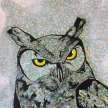Bird Feeder Related Diseases
Presented by Dr. Brian Stevens

Dr. Brian Stevens is a wildlife pathologist for the Canadian Wildlife Health Cooperative (CWHC). Most of his time is spent performing necropsy’s on birds, mammals, and the occasional reptile or amphibian. He is always looking to answer the question, “Why did this animal die?” On February 4th he took time away from the scalpel to let people across Canada know about some diseases that might be affecting birds at your feeder.
Feeders provide birds a supplemental food source, primarily attracting song birds like sparrows, chickadees, and finches but can also attract corvids such as crows, blue jays, and magpies. You may even get the occasional woodpecker. Whatever comes to visit your feeder it is important to know that bird feeders can sometimes act as a potential source of disease transmission. Sometimes, removing the feeder may be the best course of action especially if you are noticing some of your feathered visitors are not feeling well.
The three diseases Dr. Stevens sees most often are:
- Salmonellosis
- Mycoplasmosis
- Trichomonosis
Salmonellosis is caused by the bacterium Salmonella typhimurium. It is most common during cold weather like winter and spring. Songbirds are the most susceptible with most cases being seen in sparrows. It is caused by accidental ingestion of bacteria in contaminated food or water and potentially, exposure to contaminated bird feeders. Symptoms in birds include poor health (lethargy, fluffed feathers, not eating or drinking), regurgitation of food, or drooling which can cause matted feathers around the face, rapid breathing, or sudden death.
Mycoplasmosis, like salmonella, is caused by bacteria (Mycoplasma gallisepticum) and common in colder weather. It mainly affects house finches, hence the more common name House Finch Eye Disease. Outbreaks can be series, causing population declines of 40% in just two or three years. The bacteria cannot survive for long outside of the body and transmission occurs through exchanging eye or nasal discharge. This can happen when birds rub against each other or rub against the same object such as a feeder. Symptoms include swollen, red eyelids with discharge. Feathers may be matted around the eye or covered in a crust, with eyes swelling completely shut. Birds may have trouble breathing or sneeze often accompanied by symptoms of poor health.
Trichomonosis, also known as canker or frounce is caused by a parasite called Trichomonas gallinae. It is most common in the summer and early fall, associated with warmer weather. Finch species are primarily affected such as purple finches and goldfinches however it also affects pigeons, doves, and raptors. While raptors do not eat bird seed they do feed on birds that may visit your bird feeder and ingest the parasite at that time. Contaminated bird feeders and baths act as transmission sites for the parasite. Symptoms are generally caused by inflammation at the neck or throat leading to drooling, food regurgitation, difficulty swallowing, labored breathing or other signs of poor health. Birds may become emaciated.
Other diseases to watch out for include avian pox and aspergillosis. Avian pox is species specific, with different strains affecting many species including doves, turkeys and crows. Transmission is caused by biting insects. Aspergillosis is more rare, usually caused by moldy feed. It is commonly seen in waterfowl or birds under stress in rehabilitation settings.
Thinking beyond diseases other common causes of death in birds includes window strikes, predation from raptors, and domestic/feral cats. To mitigate these deaths Dr. Stevens has a few recommendations:
- Make windows bird-safe to prevent deadly collisions.
- Ensure birds have escape routes and places of cover to prevent birds of prey from overtaking song birds.
- Keep your cat inside or under supervision while outside to stop your feline friend from eating your feathered friends. Dr. Stevens built a “catio” to allow his cat to go outside for fresh air but still keep his cat and the birds safe.
To prevent diseases it is important to use the correct feeder. Metal, glass, or plastic is recommended for easy cleaning. Wood is discouraged due to its porous nature. Smaller feeders are better than larger ones to reduce crowding and increase the number of times that fresh feed will be added. Feeders should be covered to prevent the seeds from becoming wet, something like an umbrella above the feeder. Table feeders and feeders that allow feces to get into the feed are not recommended while feeders that are more specialized and limit the number of species frequenting the feeder are recommended.
Bird feeders should be cleaned at least twice a month. Gloves should be worn to protect against salmonella transmission. Feeders should be taken apart into their individual components, scrubbed with hot soapy water then disinfected using a 1:9 ratio of bleach:warm water immersion. Thoroughly rinse after disinfecting and allow it to air dry before refilling with fresh feed. Soggy, moldy feed should be removed from feeders as soon as possible.
The best part about having a bird feeder is watching all the birds that come visit. Monitor your birds and keep an eye out for symptoms of disease like lethargy, not eating or drinking, swelling of the neck or eye, and matting of feathers. If you suspect signs of disease remove the feeder or bird bath, clean and disinfect it and wait until the next season to put the item out again.
An excellent alternative to bird feeders is creating a bird friendly yard which would include habitat for natural foraging. This would include sources of food, water, and shelter to attract birds and reduce disease transmission. Suggestions include providing a mix of canopy trees, deadwood (also known as snags), shrubs, wildflowers, grasses, and other plants such as nectar producing plants for hummingbirds.
CWHC is a nonprofit organization that researches and surveils wildlife diseases across Canada. If you suspect signs of disease or find a dead animal Dr. Stevens encourages everyone to report it to CWHC by phone or email. Corpses can be double bagged and placed in the freezer until CWHC is able to get a cooler to you. CWHC does not charge for shipping or submission.
Click to learn more about CWHC then click Reports > Assessments, Strategies and Opinions > Strategies to Prevent and Control Bird Feeder Associated Diseases and Threats to download a PDF and learn more about the diseases.
If you notice a bird (or other animal) suffering from signs of disease contact your local wildlife refuge. Hobbitstee is located in Jarvis, Ontario. If you live in Ontario visit www.ontario.ca/page/find-wildlife-rehabilitator for a list of other centers. The presentation was hosted by Hobbitstee Wildlife Refuge over Zoom on February 4/2021.
-----
Written by Kelsey Reich on Feb 4/2021
About the Creator
Kelsey Reich
🏳️🌈 Life-long learner, artist, creative writer, and future ecologist currently living in Ontario.
Find me on Facebook, Twitter, Instagram, and buy me a coffee @akelseyreich!
Your support is appreciated!
Want to join Vocal+? Click here!






Comments
There are no comments for this story
Be the first to respond and start the conversation.